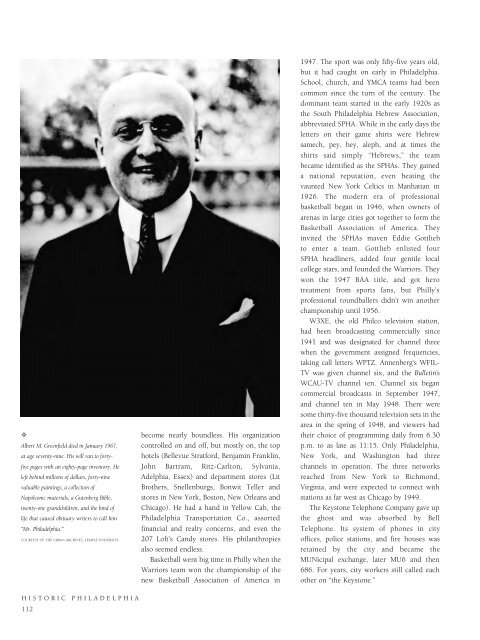Historic Philadelphia
An illustrated history of the city of Philadelphia, paired with the histories of companies, families and organizations that make the region great.
An illustrated history of the city of Philadelphia, paired with the histories of companies, families and organizations that make the region great.
Create successful ePaper yourself
Turn your PDF publications into a flip-book with our unique Google optimized e-Paper software.
✧<br />
Albert M. Greenfield died in January 1967,<br />
at age seventy-nine. His will ran to fortyfive<br />
pages with an eighty-page inventory. He<br />
left behind millions of dollars, forty-nine<br />
valuable paintings, a collection of<br />
Napoleonic materials, a Gutenberg Bible,<br />
twenty-one grandchildren, and the kind of<br />
life that caused obituary writers to call him<br />
“Mr. <strong>Philadelphia</strong>.”<br />
COURTESY OF THE URBAN ARCHIVES, TEMPLE UNIVERSITY.<br />
HISTORIC PHILADELPHIA<br />
112<br />
become nearly boundless. His organization<br />
controlled on and off, but mostly on, the top<br />
hotels (Bellevue Stratford, Benjamin Franklin,<br />
John Bartram, Ritz-Carlton, Sylvania,<br />
Adelphia, Essex) and department stores (Lit<br />
Brothers, Snellenburgs, Bonwit Teller and<br />
stores in New York, Boston, New Orleans and<br />
Chicago). He had a hand in Yellow Cab, the<br />
<strong>Philadelphia</strong> Transportation Co., assorted<br />
financial and realty concerns, and even the<br />
207 Loft’s Candy stores. His philanthropies<br />
also seemed endless.<br />
Basketball went big time in Philly when the<br />
Warriors team won the championship of the<br />
new Basketball Association of America in<br />
1947. The sport was only fifty-five years old,<br />
but it had caught on early in <strong>Philadelphia</strong>.<br />
School, church, and YMCA teams had been<br />
common since the turn of the century. The<br />
dominant team started in the early 1920s as<br />
the South <strong>Philadelphia</strong> Hebrew Association,<br />
abbreviated SPHA. While in the early days the<br />
letters on their game shirts were Hebrew<br />
samech, pey, hey, aleph, and at times the<br />
shirts said simply “Hebrews,” the team<br />
became identified as the SPHAs. They gained<br />
a national reputation, even beating the<br />
vaunted New York Celtics in Manhattan in<br />
1926. The modern era of professional<br />
basketball began in 1946, when owners of<br />
arenas in large cities got together to form the<br />
Basketball Association of America. They<br />
invited the SPHAs maven Eddie Gottlieb<br />
to enter a team. Gottlieb enlisted four<br />
SPHA headliners, added four gentile local<br />
college stars, and founded the Warriors. They<br />
won the 1947 BAA title, and got hero<br />
treatment from sports fans, but Philly’s<br />
professional roundballers didn’t win another<br />
championship until 1956.<br />
W3XE, the old Philco television station,<br />
had been broadcasting commercially since<br />
1941 and was designated for channel three<br />
when the government assigned frequencies,<br />
taking call letters WPTZ. Annenberg’s WFIL-<br />
TV was given channel six, and the Bulletin’s<br />
WCAU-TV channel ten. Channel six began<br />
commercial broadcasts in September 1947,<br />
and channel ten in May 1948. There were<br />
some thirty-five thousand television sets in the<br />
area in the spring of 1948, and viewers had<br />
their choice of programming daily from 6.30<br />
p.m. to as late as 11:15. Only <strong>Philadelphia</strong>,<br />
New York, and Washington had three<br />
channels in operation. The three networks<br />
reached from New York to Richmond,<br />
Virginia, and were expected to connect with<br />
stations as far west as Chicago by 1949.<br />
The Keystone Telephone Company gave up<br />
the ghost and was absorbed by Bell<br />
Telephone. Its system of phones in city<br />
offices, police stations, and fire houses was<br />
retained by the city and became the<br />
MUNicipal exchange, later MU6 and then<br />
686. For years, city workers still called each<br />
other on “the Keystone.”
















